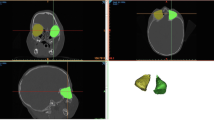Abstract
Purpose
To evaluate the efficacy of fronto-orbit reconstruction surgery on pediatric metopic synostosis via an image-based 3D reconstruction in Chinese population.
Methods
Thirty pediatric metopic synostosis patients who received fronto-orbital reconstruction surgery in the Children’s Hospital of Nanjing Medical University, Department of Neurosurgery, from January 2007 to December 2018 were analyzed in the study. Here we use the Mimics 20.0 software to reconstruct patients’ cranial thin-section CT scan images from pre- and post-operation and control groups. Then the data of intracranial volume, frontal volume, orbital hypertelorism, ECA, ZF, and ORA were analyzed using the paired t-test or Wilcoxon matched-pairs signed-ranks test.
Results
The age of these patients was 15.83 ± 16.12 months. After surgery, the mean frontal volume was enlarged from 92.75 ± 26.97 to 138.62 ± 47.97 cm3 (P < 0.0001), and the intracranial volume was enhanced from 976.87 ± 230.83 to 1059.44 ± 217.98 cm3 (P < 0.0001). In the meantime, the ECA was changed from 108.02 ± 8.17 to 134 ± 5.59° (P < 0.0001). In line with the alteration of the parameters mentioned above, the head shapes in all patients were also significantly improved after the surgery with no obvious complications.
Conclusion
Fronto-orbit reconstruction surgery is a safe and effective treatment for pediatric metopic synostosis. Computer-aided 3D reconstruction could serve as a quantitative strategy to evaluate the efficacy of craniofacial surgery.


Similar content being viewed by others
References
Abbott AH, Netherway DJ, Niemann DB, Clark B, Yamamoto M, Cole J et al (2000) CT-determined intracranial volume for a normal population. J Craniofac Surg 11:211–223
Beckett JS, Chadha P, Persing JA, Steinbacher DM (2012) Classification of trigonocephaly in metopic synostosis. Plast Reconstr Surg 130:442e–447e
Cohen SR, Persing JA (1998) Intracranial pressure in single-suture craniosynostosis. Cleft Palate Craniofac J 35:194–196
Freudlsperger C, Steinmacher S, Bachli H, Somlo E, Hoffmann J, Engel M (2015) Metopic synostosis: measuring intracranial volume change following fronto-orbital advancement using three-dimensional photogrammetry. J Craniomaxillofac Surg 43:593–598
Gault DT, Renier D, Marchac D, Ackland FM, Jones BM (1990) Intracranial volume in children with craniosynostosis. J Craniofac Surg 1:1–3
Gociman B, Blagg R, Agko M, Goodwin I, Kestle JR, Siddiqi F (2014) The metopic angle: a novel assessment tool of the trigonocephalic frontal deformity and its correction. J Craniofac Surg 25:2101–2104
Gripp KW, Zackai EH, Stolle CA (2000) Mutations in the human TWIST gene. Hum Mutat 15:479
Havlik RJ, Azurin DJ, Bartlett SP, Whitaker LA (1999) Analysis and treatment of severe trigonocephaly. Plast Reconstr Surg 103:381–390
Kan SH, Elanko N, Johnson D, Cornejo-Roldan L, Cook J, Reich EW et al (2002) Genomic screening of fibroblast growth-factor receptor 2 reveals a wide spectrum of mutations in patients with syndromic craniosynostosis. Am J Hum Genet 70:472–486
Karabagli P (2013) Pathology in metopic synostosis. Childs Nerv Syst 29:2165–2170
Kellogg R, Allori AC, Rogers GF, Marcus JR (2012) Interfrontal angle for characterization of trigonocephaly: part 1: development and validation of a tool for diagnosis of metopic synostosis. J Craniofac Surg 23:799–804
Kjaer I (1995) Human prenatal craniofacial development related to brain development under normal and pathologic conditions. Acta Odontol Scand 53:135–143
Maltese G, Tarnow P, Wikberg E, Bernhardt P, Lagerlof JH, Tovetjarn R et al (2014) Intracranial volume before and after surgical treatment for isolated metopic synostosis. J Craniofac Surg 25:262–266
Mardini S, Alsubaie S, Cayci C, Chim H, Wetjen N (2014) Three-dimensional pre-operative virtual planning and template use for surgical correction of craniosynostosis. J Plast Reconstr Aesthet Surg 67:336–343
McKay DR, Davidge KM, Williams SK, Ellis LA, Chong DK, Teixeira RP et al (2010) Measuring cranial vault volume with three-dimensional photography: a method of measurement comparable to the gold standard. J Craniofac Surg 21:1419–1422
Netherway DJ, Abbott AH, Anderson PJ, David DJ (2005) Intracranial volume in patients with nonsyndromal craniosynostosis. J Neurosurg 103:137–141
Posnick JC, Armstrong D, Bite U (1995) Metopic and sagittal synostosis: intracranial volume measurements prior to and after cranio-orbital reshaping in childhood. Plast Reconstr Surg 96:299–309; discussion 310-295
Ruiz-Correa S, Starr JR, Lin HJ, Kapp-Simon KA, Sze RW, Ellenbogen RG et al (2008) New severity indices for quantifying single-suture metopic craniosynostosis. Neurosurgery 63:318–324; discussion 324-315
Sgouros S, Hockley AD, Goldin JH, Wake MJ, Natarajan K (1999) Intracranial volume change in craniosynostosis. J Neurosurg 91:617–625
Speltz ML, Kapp-Simon KA, Cunningham M, Marsh J, Dawson G (2004) Single-suture craniosynostosis: a review of neurobehavioral research and theory. J Pediatr Psychol 29:651–668
van der Meulen J, van der Hulst R, van Adrichem L, Arnaud E, Chin-Shong D, Duncan C et al (2009) The increase of metopic synostosis: a pan-European observation. J Craniofac Surg 20:283–286
Vergnaud E, Vecchione A, Blanot S, di Rocco F, Arnaud E, Renier D et al (2012) Reducing blood losses and transfusion requirements in craniosynostosis surgery: an endless quest? Anesthesiology 116:733–734; author reply 734-735
Funding
This work was supported by Nanjing Medical Technology Development Fund (YKK16189).
Author information
Authors and Affiliations
Corresponding author
Ethics declarations
Conflict of interest
The authors have declared that no competing interests exist.
Additional information
Publisher’s note
Springer Nature remains neutral with regard to jurisdictional claims in published maps and institutional affiliations.
Supplementary Information
ESM 1
(XLSX 17 kb)
Rights and permissions
About this article
Cite this article
Yan, Q., He, J., Gao, Z. et al. Evaluation of fronto-orbital reconstruction surgery for the treatment of metopic synostosis in Chinese population. Childs Nerv Syst 37, 1167–1174 (2021). https://doi.org/10.1007/s00381-020-04977-w
Received:
Accepted:
Published:
Issue Date:
DOI: https://doi.org/10.1007/s00381-020-04977-w




